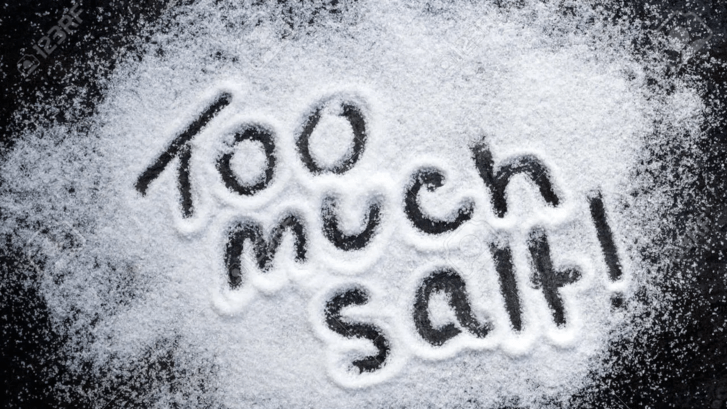We’re Still Consuming Too Much Salt, WHO Warns
Our concierge primary care doctors in Jupiter often caution our patients about their salt intake, but now a new report from the World Health Organization (WHO) appears to lend new weight to that advice.
Unless governments act to restrict the salt content in our food, seven million people will die unnecessarily from diseases linked to excessive salt consumption, the WHO warned last month.
“Unhealthy diets are a leading cause of death and disease globally, and excessive sodium intake is one of the main culprits,” WHO Director-General Dr. Tedros Adhanom Ghebreysesus said in a statement.
“This report shows that most countries are yet to adopt any mandatory sodium reduction policies, leaving their people at risk of heart attack, stroke, and other health problems,” he added.
The Damage Salt Does
“Excessive sodium intake is the top risk factor for an unhealthy diet, and it is responsible for 1.8 million deaths each year,” Francesco Branca, director of the WHO’s Department of Nutrition for Health and Development, explained.
“This is really something that doesn’t cost money to anybody,” he said. “It’s a simple intervention, but it’s incredibly effective.”
Science has known for decades that too much salt is harmful.
The American Heart Association (AHA) says, “[T]he science behind sodium reduction is clear. Significant evidence links excess sodium intake with high blood pressure, which increases the risk of heart attack, stroke, and heart failure.”
“Sodium,” by the way, is not the same as salt. Salt, or sodium chloride, is a crystal-like compound that is abundant in nature. Sodium is a mineral, and one of the chemical elements found in salt. Nevertheless, most people tend to use the two words interchangeably.
“If you retain more salt in the body, it slowly puts up the blood pressure,” Graham MacGregor, a professor of cardiovascular medicine at the Queen Mary University of London, told The Washington Post.
“That raised blood pressure then causes strokes, heart attacks, or heart failure,” he explained. MacGregor was not involved in the study, but campaigns in favor of reducing salt intake.
History of Salt
Humans have used salt since ancient times, to preserve food as well as to flavor it. Cities around the world sprang up near sources of salt, according to Wikipedia.
But we’re getting too much of a good thing. The average American today consumes 55 percent more salt than in 1980, large thanks to the proliferation of processed foods.
When food began to be mass-produced, manufacturers quickly discovered that salt not only preserved their products longer and enhanced the flavor of less-flavorful foods, but also caused consumers to crave more of it.
At least one 2016 study on mice by Australian researchers appeared to identify the opioid system in the central amygdala region of the brain as the mechanism linked to our addiction to salt, the same pathway responsible for our addiction to drugs.
“It wasn’t until now known that our natural opioids working in this emotional hotspot drove salt cravings,” neuroscientist Craig Smith of the Florey and Deakin University, told the Sydney Morning Herald.
So salt begets a desire for more salt, and manufacturers are happy to comply. It’s far cheaper to add loads of salt to a product than to use more expensive herbs and spices.
The Scoop on Salt
There’s no denying that we need a certain amount of salt to live. To maintain bodily functions, we require approximately 500 milligrams per day.
Moderate amounts of sodium also help maintain the extracellular fluid necessary for the cells’ function. Without adequate sodium, the body’s fluids would dehydrate, resulting in low blood pressure and death.
The current dietary guidelines recommend 2,300 milligrams of sodium per day. The AHA recommends even less (about 1,500 milligrams) for those at risk of heart disease. This includes adults ages 51 and older, Blacks, and those with high blood pressure, diabetes, or chronic kidney disease.
Most Americans, however, consume an average of 3,400 milligrams of sodium per day.
According to the U.S. Food and Drug Administration (FDA), sodium attracts water, and a high-sodium diet draws water into the bloodstream, thus increasing the volume of blood and subsequently your blood pressure.
Over time, high blood pressure (hypertension) injures blood pressure walls, leading to the build-up of plaque that blocks blood flow. Because hypertension causes the heart to work too hard, the high force of blood flow can harm arteries and organs throughout the body (heart, kidneys, brain, and eyes).
How to Cut Back
According to the AHA, more than 70 percent of the sodium we consume comes from packaged and restaurant foods.
“That can make it hard to control how much sodium you eat because it’s added to your food before you buy it,” the organization says.
Nevertheless, there are things you can do:
- Compare labels, looking for the lowest amount of sodium you can find.
- Pick fresh and frozen poultry that hasn’t been injected with a sodium solution.
- Opt for canned vegetables labeled “no salt added” and frozen vegetables without salty sauces.
- Drain and rinse canned beans and vegetables.
- Cook pasta, rice, and hot cereal without salt.
- At restaurants, ask for your dish to be made without extra salt.
One final tip: Incorporate foods with potassium like sweet potatoes, potatoes, greens, tomatoes and lower-sodium tomato sauce, white beans, kidney beans, nonfat yogurt, oranges, bananas, and cantaloupe. Potassium helps counter the effects of sodium and may help lower your blood pressure.

